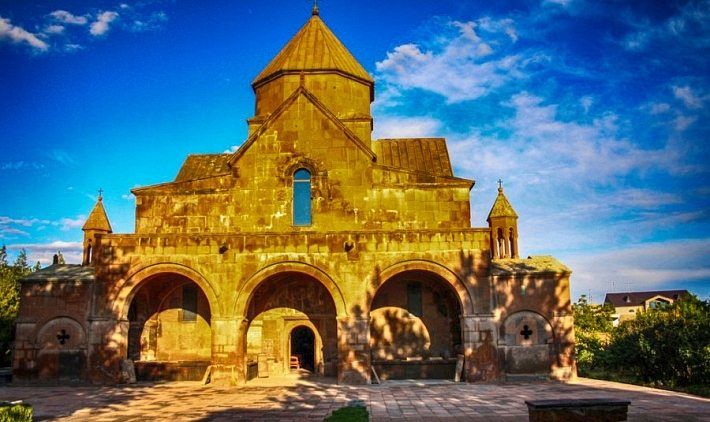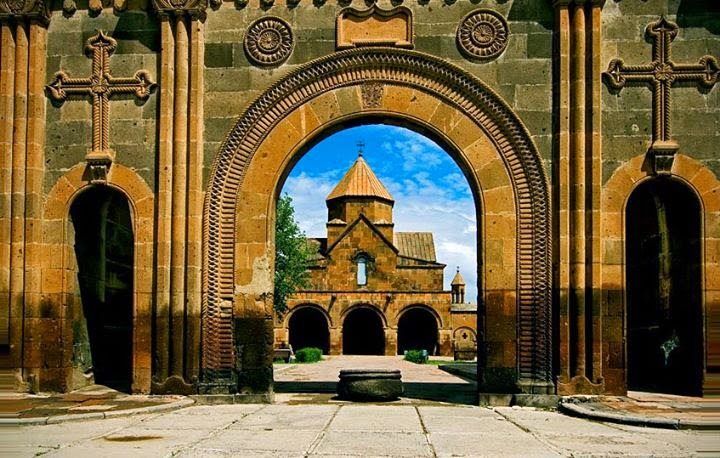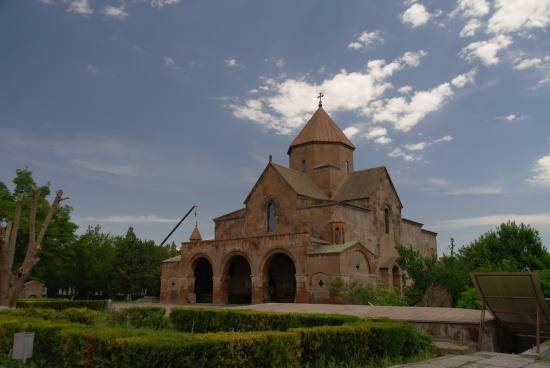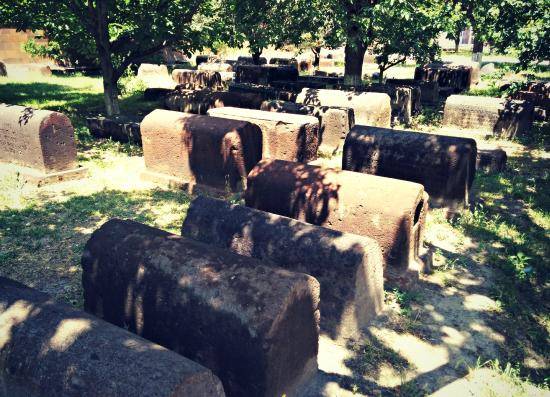Saint Gayane Church is one of the Armenian signs of wealth. The Church’s history on the back, the architecture prove that Armenians had a unique culture. This is an Armenian apostolic church of 7th-century in Vagharshapat (Ejmiatsin). Just a walking distance separates the church from the Ejmiatsin Cathedral.
The church was named after Gayane, who was among St Hripsime’s companions. She was an abbess. Tiridates III killed them as Hripsime didn’t agree to marry him.
In 2000, along with other historical churches of Vagharshapat, Saint Gayane Church was listed in the UNESCO World Heritage Sites.
The Story of St Hripsime and St Gayane
The Roman Emperor Diocletian wanted to marry one more time and he sent his people to check every part of his empire and bring to him the most beautiful girl. Emperor’s people showed some beautiful nuns pictures. After watching those pictures he mostly liked Hripsime, who was living in St Poghos Monastery with, around, 300 nuns. The abbess of the monastery was Gayane, Hripsime’s preceptor. Diocletian Emperor seeing the picture of beauteous Hripsime wanted to marry her.
Knowing the desire of the Emperor, Gayane, Hripsime and around 70 nuns and scholars left the St Poghos Monastery at night and went to Egypt, Alexandria. Later they went to Jerusalem, and prayed for one month at the grave of Mother of Jesus, asking help from her. Mary appeared to them and ordered to go to Armenia. In Vagharshapat, nuns stayed at Wine Presses. Before, the Wine presses were from town’s gate till today’s St Hripsime’s Church. The main gate “Areg” is on the crossroad of Mashtots Avenue and Spandaryan street.
For reading the continuation of the story, follow the link.
In 1141 St Ejmitsin became an Armenian Patriarchial Seat. After that, since 1443, there have been many efforts to renovate Ejmiatsin and other monasteries around it. But, because of the historical and political unfavourable conditions, either these attempts stay incomplete, or partly done. From the description of Arakel Davrizhetsi, we can understand that the condition of Ejmiatsin and other three churches were desolate in the first quarter of the seventeenth century.
The Chapel and the history of Cathedral
St Grigor Lusavorich (301-325)
As Tirridates III had ordered not bury Hripsime and her companions’ bodies, but predacious animals didn’t touch their corpses. After coming out of Khor Virap (“deep dungeon”), St Grigor Lusavorich firstly gathered nuns’ bodies and buried honorary.
The narrator Agatangeghos describing the martyrdom of nuns tells that even when nuns bodies were unburied, no change happened to them till Grigor Lusavorich came out of Khor Virap.
The patriarch individually buried the bodies of St Hripsime and St Gayane in different coffins beside other nuns. Grigor Lusavorich established three chapels on the places where nuns were buried. Agatangeghos wrote about the speech that Grigor Lusavorich said to the people:
” Let us bury the heavenly treasure so that it gives all of your pains a treatment. May they have a peace, and let us build chapels on their graves. Let us ask God a peace and mercy for the world. And may the kingdom of the God be in our country”.
So, with the help of Grigor Lusvorich’s efforts, three chapels were built: one was in the northeastern part of the city where Hripsime died with her 32 friends, the second one in the southern part where Gayane died with her two friends, and the third one in the garden, where nuns were living.
St Sahak Partev (387-436)
After the martyrdom of the nuns, Sahak Partev wanted to renovate the chapels, that was destroyed during the invasions of Shapuh in 364-368. He ordered to destroy the decrepit walls of the chapels, but he didn’t dare to open their graves, but he added his patriarchial mark and again buried in their places. Patriarch Sahak Partev established new little and more convenient chapels instead of old ones, that was standing on nuns’ graves as a private Martyriums, till the period of Komitas and Yezr patriarchs.
Komitas I Aghtsetsi (615-628)
Komitas Patriarch is one of the most remarkable patriarchs of Armenian Church. He is the author of “Devoted Souls” lyrical sharakan. He renovated the grave of St Hripsime.
Yezr I Parazhnakertsi (630-641)
After two years of Komitas Patriarch’s death, Yezr Patriarch gets the patriarchal seat. Instead of the destroyed chapel of St Gayane, he establishes a wide cathedral in 630. During the construction, he renovates lodgings around the cathedral. St Gayane Church is 100 metres far from Ejmiatsin, in southwest part.
About St Gayane Church’s construction, Hovhannes Draskhanakertsi wrote, that Yezr Patriarch established a simple and wide cathedral.
So, instead of the Martyriums of St Gayane and St Hripsime two patriarchs established magnificent cathedrals, where, till now, every visitor enters with a great admiration. As in the past, nowadays also these two cathedrals grabs not only Armenian but also foreign tourists attentions.
Since seventh century some known patriarchs also do a huge work by constructing and renovating the cathedrals of Vgharshapat and other churches. Here are some of their names: Pilipos I Aghbakesi, Yeghiazar I Ayntaptsi, Georg IV Kostandnupolsetsi, Vazgen I Paltchyan and Garegin II Nersisyan patriarchs.
The Murals of St Gayane Cathedral
The murals of St Gayane Cathedral have an aesthetic and cultural high value. These are unique works of art. Nowadays there are fewer murals in Armenian cathedrals. Of course, we can see remarkable murals in the mother Cathedral, and some of them are non-figurative and compositional works. The date of the mother Cathedral takes us to the period of Astvatsatur I Hamadantsi patriarch ( 1715-1725).
After Astvatsatur patriarch, there were traceries during Karapet and Abraham patriarchs’ period.
The murals of the mother Cathedral are attributed to the famous dynasty of Hovnatanyants. In contrast to the mother Cathedral, St Gayane’s murals date goes back to 1688.
Above the western central entrance, you can see a picture of Jesus’s Dedication to the Cathedral. In the picture is Jerusalem city and the Cathedral of Jerusalem. In the middle is Simeon, who is keeping child Christ in his hands. On the right side of Simeon is St Mary, and on the left side is standing Hovsep, Anna prophet and two unknown people. The mural is in a good condition. It’s drawn by natural temperas.
In the southern part of the Belfry is the portrait of Jesus accompanied by two angels. This is really a great work of art.
In the northern part of St Gayane Cathedral, there is the drawing of St Petros apostle carrying keys in his hand. Beside the Apostle, you can see a pillar, where a cock is sitting. Near the central entrance is Yeghiazar I Ayntaptsi patriarch’s drawing.
In the northern part of St Gayane Cathedral, there is a scene of Jesus Christ’s Crucifixion. In the middle of the picture is Jesus, whom people are taking down with many shrouds. Downwards of the scene of Crucifixion, there are St Mariam, Mariam Magdaghenatsi and Hovhannes Apostle. There also some buildings of Jerusalem. In the northern and southern sections of the Belfry, there are four khachkars, that are on the walls of Belfry.
There are also some other icons. So here is the icon of:
- St Gayane nun- though this is a copy of Hovnatanyan’s work, it has a great look and high level of art,
- St Mary- the icon is hanging on the left pillar of the cathedral,
- Andranik Antonyan’s “St Mary with child Jesus”,
- St Grigor Lusavorich,
- St Gayane’s picture- is on the portal of the grave of Gayane,
- Martyrdom of St Gayane
Other icons you can see by just visiting St Gayane Church.











Leave a Comment